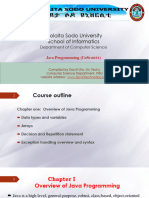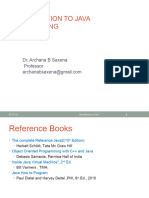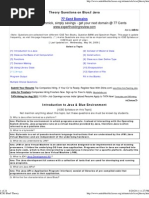jvm-notes_class-9
Uploaded by
asmita21cjvm-notes_class-9
Uploaded by
asmita21cCOMPUTER APPLICATION
CLASS IX
QUESTIONS AND ANSWERS OF JAVA
Problem 1
How can you say that java is both a programing language and platform?
Solution. Like any other programming language, we can use java to write or
create various types of computer applications. The word platform generally is
used to refer to so9me combination to hardware and system software, the java
platform is a new software platform designed to deliver and run highly
interactive, dynamic and secure applications on networked computer system.
Problem 2. How is ordinary compilation different from java compilation?
Solution. In ordinary compilation the source code is converted to a machine code
which is depended upon the machine or the platform. This resultant machine
code is called native executable code.
Contrary to ordinary compilers the java compiler does not produce native
executable code for a particular machine, instead it produce a special format
called byte code. The java byte code looks a lot like machine language, but unlike
machine language jave byte code is exactly the same on every platform.
Problem 3.What do you understand by JVM?
The java virtual machine is an abstraction designed to be implemented on the top
of existing processors. It hide the underlying operating system from java
applications Programs written in java are compiled into java byte code, which is
then interpreted by a special java interpreter for a specific platform. Actually this
java interpreter is known as the Java Virtual Machine
(JVM)
Problem 4. Name two types of java programs.
Solution. There are two types of java programs, Internet applets and stand alone
applications.
i. Internet Applets are small program that are embedded in web pages
and are run on the viewer’s machine in a secured manner (which means
limited access to system re-sources i.e., the hard disk) by java capable
browsers.
Applets are designed to deliver to internet Web browser and that is way an applet
has built-in graphical window. But java applets have some security restrictions
(e.g., it cannot write to a local file).
ii. The second types of java program, stand alone applications, is generally
a software application that does not require low level operating system
or hardware access. Every stand alone application of java begins
executing with a main method.
Problem 5. Define the term Byte Code.
Ans. Java bytecode is the result of the compilation of a Java program, an intermediate
representation
of that program which is machine independent. The Java bytecode gets processed by the Java
virtual machine (JVM) instead of the processor.
Problem 6. State the difference between Applet and Application.
Ans. The fundamental difference between the two Java programs is that an application
program is designed to run on a stand-alone machine whereas an applet is a web-version of an
application which is used to run a program on a web browser.
You might also like
- Class - 8 - Computer - Chapter-2 Questions & Answers (3) 1No ratings yetClass - 8 - Computer - Chapter-2 Questions & Answers (3) 111 pages
- Introduction To Java: Class 10 - Logix Kips Icse Computer Applications With BluejNo ratings yetIntroduction To Java: Class 10 - Logix Kips Icse Computer Applications With Bluej9 pages
- R.P. Bhalodia BCA College: History of JavaNo ratings yetR.P. Bhalodia BCA College: History of Java33 pages
- Object Oriented Programming : Through JavaNo ratings yetObject Oriented Programming : Through Java68 pages
- Wolaita Sodo University School of Informatics: Department of Computer ScienceNo ratings yetWolaita Sodo University School of Informatics: Department of Computer Science50 pages
- Object Oriented Programming : Through JavaNo ratings yetObject Oriented Programming : Through Java68 pages
- Introduction To Programming Language and JavaNo ratings yetIntroduction To Programming Language and Java12 pages
- Lecture – 2 Introduction to Java, Key FeaturesNo ratings yetLecture – 2 Introduction to Java, Key Features5 pages
- What Is Java ?: Platform: Any Hardware or Software Environment in Which A Program Runs, Is Known AsNo ratings yetWhat Is Java ?: Platform: Any Hardware or Software Environment in Which A Program Runs, Is Known As8 pages
- Beginning Java 7 1st Edition Jeff Friesen - Read the ebook online or download it to own the full content100% (1)Beginning Java 7 1st Edition Jeff Friesen - Read the ebook online or download it to own the full content60 pages
- JAVA: Java Programming for beginners teaching you basic to advanced JAVA programming skills!From EverandJAVA: Java Programming for beginners teaching you basic to advanced JAVA programming skills!No ratings yet
- Chapter 1 Diesel Engine With SupplementNo ratings yetChapter 1 Diesel Engine With Supplement18 pages
- "I-MCQ": "Bhagwan Mahavir College of Computer Application (BCA) "No ratings yet"I-MCQ": "Bhagwan Mahavir College of Computer Application (BCA) "124 pages
- Mitsubishi PLC PID Control InstructionsNo ratings yetMitsubishi PLC PID Control Instructions110 pages
- Types of Software Testing Powerpoint PresentationNo ratings yetTypes of Software Testing Powerpoint Presentation52 pages
- CSE4017 - SOFTWARE-TESTING - LT - 1.0 - 1 - Software TestingNo ratings yetCSE4017 - SOFTWARE-TESTING - LT - 1.0 - 1 - Software Testing2 pages
- Ganesh Santhar Huawei 4.05 Years BangaloreNo ratings yetGanesh Santhar Huawei 4.05 Years Bangalore3 pages

























































































